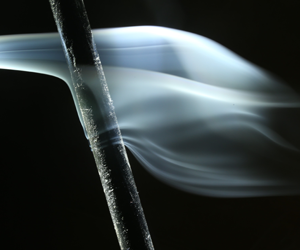Article contents
Moth-inspired methods for particle capture on a cylinder
Published online by Cambridge University Press: 17 December 2019
Abstract

We study particle capture on an angled cylinder at a range of Péclet numbers. This system was inspired by the plumose antennae of certain species of male moths that intercept female pheromones at low Péclet numbers of 0.9–23. We use confocal microscopy to measure the branching patterns of 49 moths, spanning 12 families and two orders of magnitude in mass. Among the three levels of hierarchy in antennae, we find the middle level has a prevalent branching angle,  $52^{\circ }\pm 12^{\circ }$ across our study set. Such intermediate branching angles are a surprising way to intercept molecules because they do not maximize the exposed surface area. To understand the benefits of angling cylinders into the flow, we study particle collection at high Péclet number using
$52^{\circ }\pm 12^{\circ }$ across our study set. Such intermediate branching angles are a surprising way to intercept molecules because they do not maximize the exposed surface area. To understand the benefits of angling cylinders into the flow, we study particle collection at high Péclet number using  $10~\unicode[STIX]{x03BC}\text{m}$ drops that are several orders of magnitude larger than moth pheromones. Wind tunnel tests show that cylinders angled at
$10~\unicode[STIX]{x03BC}\text{m}$ drops that are several orders of magnitude larger than moth pheromones. Wind tunnel tests show that cylinders angled at  $30^{\circ }{-}60^{\circ }$ are optimal for collection of particles, collecting 30 % more than when perpendicular to the flow. Simulations and smoke visualization show that angled cylinders bend incoming streamlines, creating a lingering effect near the cylinder that can enhance deposition by diffusion. We surmise that the optimal angle arises from a trade-off between the lingering effect, which decreases with increasing angle of the cylinder, and the cylinder’s increasing projected area as it is turned more perpendicular to the flow. Using a mathematical model, we show that only cylinders at low Péclet number show improved collection at intermediate angles. Thus, we cannot rationalize the high collection rates in our wind tunnel experiments at high Péclet number. We hope that our study will inspire more research into bio-inspired particle collection of angled surfaces, and find applications in sensors and filters.
$30^{\circ }{-}60^{\circ }$ are optimal for collection of particles, collecting 30 % more than when perpendicular to the flow. Simulations and smoke visualization show that angled cylinders bend incoming streamlines, creating a lingering effect near the cylinder that can enhance deposition by diffusion. We surmise that the optimal angle arises from a trade-off between the lingering effect, which decreases with increasing angle of the cylinder, and the cylinder’s increasing projected area as it is turned more perpendicular to the flow. Using a mathematical model, we show that only cylinders at low Péclet number show improved collection at intermediate angles. Thus, we cannot rationalize the high collection rates in our wind tunnel experiments at high Péclet number. We hope that our study will inspire more research into bio-inspired particle collection of angled surfaces, and find applications in sensors and filters.
JFM classification
- Type
- JFM Papers
- Information
- Copyright
- © 2019 Cambridge University Press
References
- 8
- Cited by


